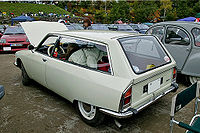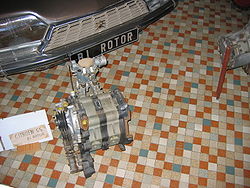- Citroën GS
-
Citroën GS/GSA 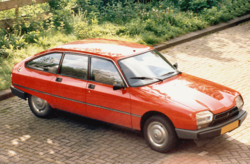
Citroën GSA SpécialManufacturer Citroën Production 1970-1986 Assembly Rennes, France[1](Chartres-de-Bretagne quarter)
Arica, Chile
Jakarta, Indonesia (Gaya Motor)[2]
Mozambique[2]
Mangualde, Portugal[2]
Vigo, Spain[2]
Port Elizabeth, South Africa[2]
Bangkok, Thailand[2]
Koper, Slovenia (Yugoslavia)[2]
Mutare, Zimbabwe[2]Predecessor None Successor Citroën BX and Citroën ZX Class Small family car Body style 4-door fastback
5-door hatchback
5-door estate
3-door vanLayout FF layout Engine 1015 cc flat-4 air-cooled
1129 cc flat-4 air-cooled
1222 cc flat-4 air-cooled
1299 cc flat-4 air-cooled
2x497.5 cc Wankel engineWheelbase 100.375 in (2,549.5 mm) Length 162.125 in (4,118.0 mm) Width 69.25 in (1,759 mm) Height 53.125 in (1,349.4 mm) Curb weight 900 kg (1,984 lb) (saloon)
950 kg (2,094 lb) (hatchback)
925 kg (2,039 lb) (3-door van)
(all weights approximate)Designer Robert Opron The Citroën GS (1970–80) and Citroën GSA (1979–86) are small family cars produced by the French automaker Citroën. The GS was voted European Car of the Year for 1971, and was probably the most technologically advanced car in its class when launched,[3] with class leading comfort, safety and aerodynamics.[citation needed]
Contents
Market placement
The GS filled the enormous gap in Citroën's range, between the 2CV and Ami economy cars and the luxurious DS. Leaving this market gap open for fifteen years allowed other manufacturers entry into the most profitable market segment in France. This combined with the development costs and new factory for the DS-replacing Citroen CX, the 1974 oil crisis, and an aborted Wankel rotary engine, led Citroën to declare bankruptcy in 1974.
The GS met with instant market acceptance and was the largest selling Citroën model for many years. 1,896,742 GS models and 576,757 GSA models were produced in total.
The GS was never officially imported to the USA.
Design stage
Work began on the concept of a small family car as early as 1960, with the "C60", to slot between the 1961 Citroën Ami and DS. This project continued in various forms for a decade, with a Wankel engine and typically Citroën hydropneumatic suspension suggested as possibilities, with a new, modern body to match. In 1963, development had moved to "Project F", which was close to being production ready. Citroën decided the car was too similar to the 1965 Renault 16 and in 1967 Project F was suspended, but many of the mechanical components continued to "Project G", which became the GS.
Launch and ongoing development
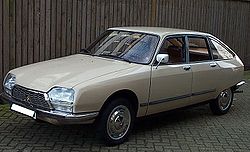 1977 GS Berline (saloon)
1977 GS Berline (saloon)
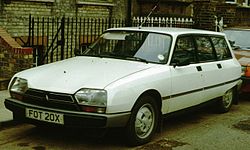 GSA Break (estate, see also shooting brake for etymology) — offered from 1972
GSA Break (estate, see also shooting brake for etymology) — offered from 1972
On 24 August 1970, Citroën launched the GS. The body style was as a "Berline" (essentially a saloon, three lateral windows), in a fastback style with a sharp Kamm tail. The aerodynamics gave the best drag coefficient of any vehicle at the time.
Good aerodynamics enabled the car to make the best of the available power, but the car as launched nevertheless drew criticism that it was underpowered. Citroën addressed the issue with the introduction in September 1972, as an option, of a larger 1,222 cc engine.[4] Claimed power increased from 55 bhp (41 kW; 56 PS) to 60 bhp (45 kW; 61 PS), but it was the improved torque that really marked out the more powerful engine, and which enabled the manufacturer, with the larger engined versions, to raise the second gear ratio and the final drive ratio, increasing the vehicle speed per 1,000 rpm from 23 km/h (14.3 mph) to 24.5 km/h (15.2 mph).[4] Larger front brake discs were also fitted.[4]
Visually the GS bore little resemblance to any other car on the market, until the development of the Citroën CX in 1974.
The GS was designed "in house" by Robert Opron and was controversial — a hatchback layout was considered too utilitarian by CEO Pierre Bercot, but was introduced later with the arrival of the GSA. The boot was nevertheless exceptionally large, in part due to the positioning of the spare wheel on top of the engine.
It was offered in two trims; GS Club as the entry model and GS Pallas (only saloons) with full wheel covers, side mouldings, tinted glass and upgraded upholstery. The GS was also available, from September 1971,[5] as a break (estate) and a similar two-door "service" van.
The GSA replaced the GS in 1979 and added a hatchback. Other modifications included a new grille, new bumpers, new taillights, new hubcaps and new exterior handles[6] . It also had a revised dashboard with the auxiliary controls on column-shaped pods so they could be reached without moving the hands from the single-spoked steering wheel; similar to the CX layout. Both the early GS (produced until 1976) and the GSA have the unusual rotating drum speedometer (similar in construction to bathroom scales), rather than the dials found in a conventional dashboard. The later GS (from 1977 until the introduction of the GSA) had a conventional speedometer.
Critics
Contemporary journalists remarked at the smooth ride quality — the hydropneumatic suspension is designed to absorb bumps and ripples that would be uncomfortable in a conventionally sprung car with just a slight body movement.
Though it won praise for the ingenuity of the design, shortcomings included manufacturing quality and corrosion resistance and the heater was doubted due to its air-cooled engine. But the most criticised aspect of the GS was the relatively low power of the various engines offered. This was driven by the "puissance fiscale" taxation system which, at that time in France, linked car tax rates directly to engine displacement. By the standards of the time, the 1015 cc GS was especially underpowered even at launch, and Citroën found themselves overstocked with engines of this size: these were eventually diverted to give an overdue power boost to the Citroën Ami.
Mechanics
The vehicle had a front-wheel drive layout and was powered by a flat-4 air-cooled engine. A series of small engines were available, displacing 1015, 1129, 1222 and 1299 cc. Power ranged from 55 PS (40 kW) to 66 PS (49 kW). Mated to a four speed gearbox, these were able to pull this car up to steady 151 km/h (94 mph) at 6250 rpm (with 1222 cc engine), due to the very aerodynamic body shape. Citroën's 3-speed C-Matic semi-automatic transmission was available as an alternative to the manual gearbox. With the introduction of the GSA a 5-speed gearbox was offered, which made cruising at high speeds more comfortable and economical (the top speed was raised to 164 km/h (102 mph) for both long and short gearbox ratios [7]). The GS and GSA were always low powered and needed full use of the free-revving engines to maintain progress, except when cruising, in the tradition of the Citroën 2CV.
The four-wheel independent suspension featured a double wish-bone layout at the front and trailing arms at the rear. Both axles comprised rigid sub frames that gave the car unmatched road holding for the time, even on its narrow tires (factory-mounted Michelin ZX 145sr15).
Its central hydraulic system, powering the four disc brakes (inboard in front to help lower unsprung weight) and the advanced hydro-pneumatic self-levelling suspension, was derived from the Citroën DS. It also has a feature that increased or decreased braking pressure in accordance with cargo load, without any noticeable difference in the brake pedal response. The powered system was different from the typical assisted systems in that there was virtually no travel on the brake pedal even when braking hard. The hydraulic suspension allowed the car to be raised for rough terrain at low speeds (a feature taking account of the country lanes of its native France) and to full height for easy access to the partially enclosed rear wheels.
GS Birotor
A two rotor GS was launched in 1973. Dubbed the Citroën GS Birotor (also called Citroën GZ), it featured a 107 PS (79 kW) Wankel birotor produced by the joint NSU-Citroën Comotor project. This style of motor is noted for its smooth power delivery which complemented the luxurious ride quality of the hydropneumatic suspension. The Birotor was extensively reengineered, besides for the Comotor 624 engine. Discs all around (ventilated in front), different wheels with a five-bolt pattern rather than three, and a three-speed semi-automatic transmission were combined with a more luxurious interior and flared fenders to set the Birotor apart from its lesser siblings. Sadly, the Birotor was placed in the uncomfortable position of costing more than the larger, faster, more economical and less complex Citroën DS which quickly sealed its fate.
The Birotor version achieved poor sales and was quickly pulled from the market after 847 units sold. It was not economical for its size and was launched during the 1973 oil crisis.
The sales and quality were so disappointing that Citroën attempted to buy back and scrap each Birotor, as it did not want to support the model with spare parts. A few of these remarkable vehicles have nonetheless survived in the hands of collectors, many without titles for some time as Citroën did not want to recognize the cars.
GS production abroad
The GS and GSA were built in a number of countries besides France. Besides Spain, Portugal and England, production took place in countries as varied as South Africa, Chile and then Rhodesia (Zimbabwe). All three bodystyles, GS and GSA versions and a mix thereof were built in Cakung in East Jakarta, Indonesia by PT Alun Indah.[8] Indonesian production continued until at least 1990. Like the Indonesian models, Cimos in Slovenia used the twin-headlight fixtures developed for export markets on the GSs they built in Koper. For unknown reasons Slovenian GSs were almost exclusively finished in "campus beige" color. The GSA was called the GA in Yugoslavia.
GSA in German Democratic Republic
Between 1979 and 1983 around 5500 were exported to the German Democratic Republic ("East Germany") making it one of the few western cars in the country. Erich Honecker, the East German party leader, maintained a fleet of the larger CX model and several Volvos.
Documentary
- Production of the GS is described in the Louis Malle documentary film, Humain, trop humain.
See also
PSA Rennes Plant, a French language Wikipedia entry concerning the plant in the south-west of Rennes where the GS was built.
References
- ^ Citroen GS: Citroen build with care (Anglophone brochure for UK market). Slough: Citroen Cars Ltd (UK). date August 1976. .
- ^ a b c d e f g h Chiffres de Production, La Page de la GS, http://www.gs-gsa.org/chiffres-production.php
- ^ "Citroën GS". citroen.mb.ca. Archived from the original on 2008-02-13. http://web.archive.org/web/20080213013305/http://www.citroen.mb.ca/citroenet/passenger-cars/michelin/gs/gs-01.html. Retrieved 2008-02-01.
- ^ a b c "News: Bigger engine for Citroen GS". Autocar: 19. date 21 September 1972.
- ^ "News". Autocar 135 nbr 3938: Page 21. date 16 September 1971.
- ^ "Road test: 1983 Citroën GSA Spécial.". www.ranwhenparked.net. http://ranwhenparked.net/2010/06/09/road-test-1983-citroen-gsa-special/.
- ^ Revue Technique Automobile, n° 464, Feb. 1986, Ed Etai, France, ISSN 0017 307X
- ^ "About Us". PT Alun Indah Manufacturing Division. http://alunindah.com/index.php/about-us. Retrieved 2010-03-26.
External links
- Citroën GS and GSA website Lots of information and pictures about GSs and GSAs around the world, detailed production figures, technical information, history of the car and Car club information.
- la page de la GS
- Citroën World - GS & GSA links
- GS at Citroënët
- GSA at Citroënët
Type 1950s 1960s 1970s 0 1 2 3 4 5 6 7 8 9 0 1 2 3 4 5 6 7 8 9 0 1 2 3 4 5 6 7 8 9 Economy car 2CV Off-roader Méhari Supermini LN / LNA Dyane Ami Visa Small family car GS Large family car 11 CV ID / DSpécial / DSuper Executive car 15 CV DS CX Grand tourer SM « previous — Automobiles Citroën, a subsidiary of the PSA Peugeot Citroën since 1976, car timeline, 1980s–present Type 1980s 1990s 2000s 2010s 0 1 2 3 4 5 6 7 8 9 0 1 2 3 4 5 6 7 8 9 0 1 2 3 4 5 6 7 8 9 0 1 Economy car 2CV Off-roader Méhari City car C1 Supermini LN / LNA AX Dyane Axel Saxo I Saxo II C2 DS3 Visa C3 I C3 II Small family car GSA ZX Xsara I Xsara II C4 I C4 II DS4 Large family car BX Xantia C5 I C5 II DS5 Executive car CX XM C6 Leisure
activity vehicleAcadiane C15 Nemo Berlingo Berlingo II Compact
MPVXsara Picasso C3 Picasso C4 Picasso Large MPV Evasion/Synergie C8 C4 Grand Picasso Crossover C-Crosser Convertible C3 Pluriel Van H Van C25 Jumpy I Jumpy II C35 Jumper Jumper II Citroën PSA Peugeot Citroën · Category · Vehicles
Current - Europe Current - China (DPCA) Historic Trucks Concept cars G Van · Prototype C · Prototype Y · 2CV Pop · GS Camargue · C44 · Karin · Zabrus · Activa · C6 Lignage · C-SportLounge · C-Airplay · C-Buggy · C-Airdream · GT by Citroën · Hypnos · DS Inside · Revolte · Survolt · C-CactusMotorsport Electric vehicle Categories:- Citroën vehicles
- Mid-size cars
- Front wheel drive vehicles
- 1970s automobiles
- 1980s automobiles
- Vehicles introduced in 1970
- Vehicles with boxer engines
- Vehicles with Wankel engines
Wikimedia Foundation. 2010.

